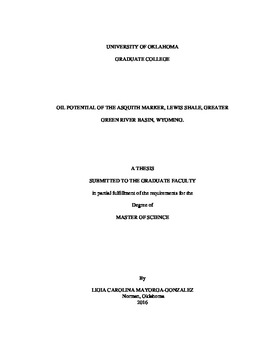| dc.description.abstract | Large volumes of gas and some oil have been produced from the Cretaceous Lewis Shale, and it is often considered a regional source of gas in the Greater Green River Basin. However, the Lewis Shale has never been studied as a potential oil-prone source or reservoir rock despite the fact that there is a small Lewis oil field on the western part of the Wamsutter arch: the Stage Stop field.
In this thesis, I evaluated the potential of the Asquith Marker as an oil-prone source rock. The Asquith Marker, in the lower Lewis Shale, is a relatively organic-rich shale easily recognizable on the gamma ray log as an anomalously high API. It is a third order condensed section that has a maximum thickness of 100ft. and covers a large area of the Greater Green River Basin.
Based upon limited subsurface data, I have evaluated samples from one cored well that penetrated the Asquith as well as samples from six other Lewis Shale cores above the Asquith Marker, five well cuttings and eight outcrop samples from the As-quith Marker. Structure and stratigraphic maps have been compiled and used to identi-fy the areas where the Asquith Marker is thickest and deep enough to generate oil. Analyses included Rock-Eval, XRD, vitrinite reflectance, and biomarker geochemis-try, from which the composition, maturity, oil potential and kerogen type were deter-mined.
Rock-Eval analysis showed some pitfalls associated with sample type (cutting and outcrop sample vs. core sample). Core samples showed high potential to generate oil from Type II kerogen. Lower TOC from cutting and outcrop samples was caused by caving, weathering and handling of the samples during the storage of the cutting samples. This low TOC also affected the parameters obtained from the Rock-Eval as HI, Tmax, OI and the S1, S2, S3 and S4 peaks from the pyrograms. Vitrinite reflec-tance from other intervals close to the Asquith Marker suggested the Asquith Marker interval is within the oil window or early oil window. Biomarker analysis was per-formed on three samples: one sample from the Amoco Champlin 276 D-1 well, one sample from the Amoco Champlin E- 1 well and one sample from Stage Stop Unit 2 well. This analysis suggested the samples are within the oil window or early oil win-dow from marine, hypersaline stratified waters with high clay content. There was also evidence of some higher plant material input.
The general sparseness of data has hindered a more robust analysis, but several indicators suggest the Asquith Marker might be oil-prone as an unconventional re-source shale. In order to define potential areas for unconventional development thick-ness, depth, vitrinite reflectance and biomarker maturity data were used as constraint. According to Jarvie (2005), the lower the TOC the thicker the shale interval must be in order to be economically viable for extraction. Depth was chosen based upon maturity and potential to generate hydrocarbons from TOC, biomarkers and vitrinite re-flectance. A depth between 1400-(-6600) ft. depth (TVDSS) was used as constraint. The total area obtained from these constraints is close to 2.5*107 acres; a map shows the aerial extent of the oil-prone Asquith Marker.
New information about two oil producing wells that were drilled as horizontal wells through the Asquith Marker (Rush Unit 4-1 and Spirit of Ratio 7-1H) is used as proof of concept. They have a total oil production of 26775 Bbls. and 14350 Bbls. respectively but the decline rate characteristics of unconventional wells led to the abandonment of the Rush Unit 4-1H well on 2016. | en_US |
